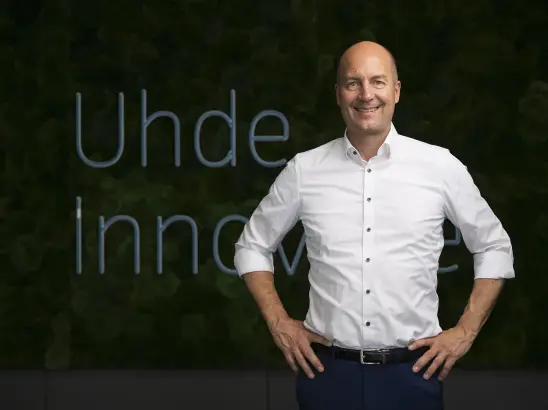And this is where thyssenkrupp Uhde comes into play ...
Exactly. We've got the technologies and we're building plants to convert green hydrogen into ammonia using nitrogen from the ambient air. This compound has a higher energy density than hydrogen, and is therefore more stable and cheaper to transport over long distances. Before use, the previously liquefied gas is split again to recover the hydrogen. In this way, the entire hydrogen chain can be mapped in a completely carbon-free way, from production in countries where solar and wind power are plentiful right through to consumption in the steel mill process, for example.
How exactly does the ammonia get to the major consumers?
There are different scenarios. In Germany, discussions are underway about converting LNG terminals at ports and on the coast over to ammonia in the future. Conversion plants, called ammonia crackers, could be built in the vicinity of these terminals. From there, the hydrogen will be transported by pipeline, so there would be a widely branched hydrogen network in the future. Another variant would be decentralized supply, close to the major centers of consumption, for example the Rhine-Ruhr region. Ammonia would then first be transported far inland, either for direct use or for conversion in smaller plants.
Production, conversion, transport: many stakeholders will have to play their part in turning the vision of a completely green hydrogen chain into reality ...
Absolutely. For the turnaround in energy and industrial policies to succeed, new collaborations and openness on the part of companies are called for. Perhaps the Scottish offshore wind turbine operator and the chemical company will then join forces to produce green chemicals. Cooperation also makes sense for keeping energy losses within the chain as low as possible. Whereby losses is actually the wrong word. After all, the energy is not lost, but is converted into heat, for example. And as such, it can also be used to some extent. The same applies to other byproducts, especially the climatically harmful CO2. In the Carbon2Chem joint project, we are testing these close-coupling mechanisms jointly with partners from industry and science. We use steel mill gases from steelmaking, and convert them into carbon-neutral chemical precursors with the help of green hydrogen. The test facility is located in Duisburg, and we are working there not only with thyssenkrupp Steel and thyssenkrupp nucera, but also with partners throughout the chemical industry. These are companies that will move closer together in green value chains.
thyssenkrupp Steel aims to cease emitting CO2 in the future. Do the CO2 utilization technologies we have just been talking about represent a transitional phase on the way to the hydrogen economy?
Don't forget that we still live in a hydrocarbon world, and carbon is not going to disappear overnight. In addition, many industrial processes worldwide will continue to use fossil fuels in the long term. Consequently, carbon recycling, or Carbon Capture & Utilization (CCU), will help us achieve climate-friendly technology chains for decades to come. In the USA, for example, with its large natural gas reserves, huge investments are currently being made in the production of so-called blue hydrogen. This means the CO2 released is captured and stored, or reused. In the import markets of Europe and Asia, however, there is still a lack of political clarity as to the conditions under which blue energy carriers will be permitted and, above all, for how long. This attitude, in turn, is making the transition more difficult, because hardly any investor will take the risk of building a plant that does not have a long-term secure market. I am convinced that, 200 years from now, we'll still be living in a world where hydrocarbons exist. And these hydrocarbons must be as green as possible.
Mr. Radtke, thank you very much for the interview!




